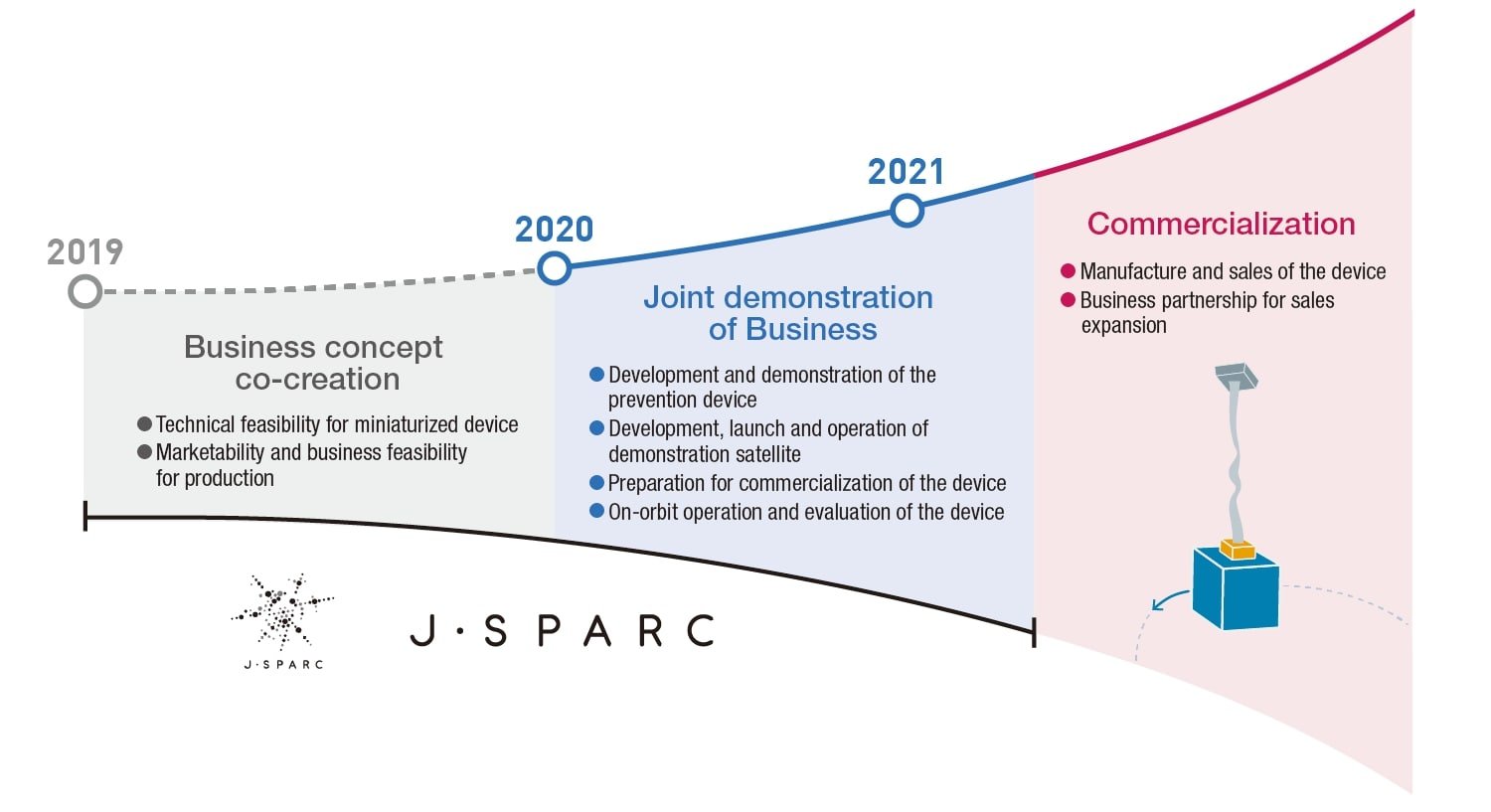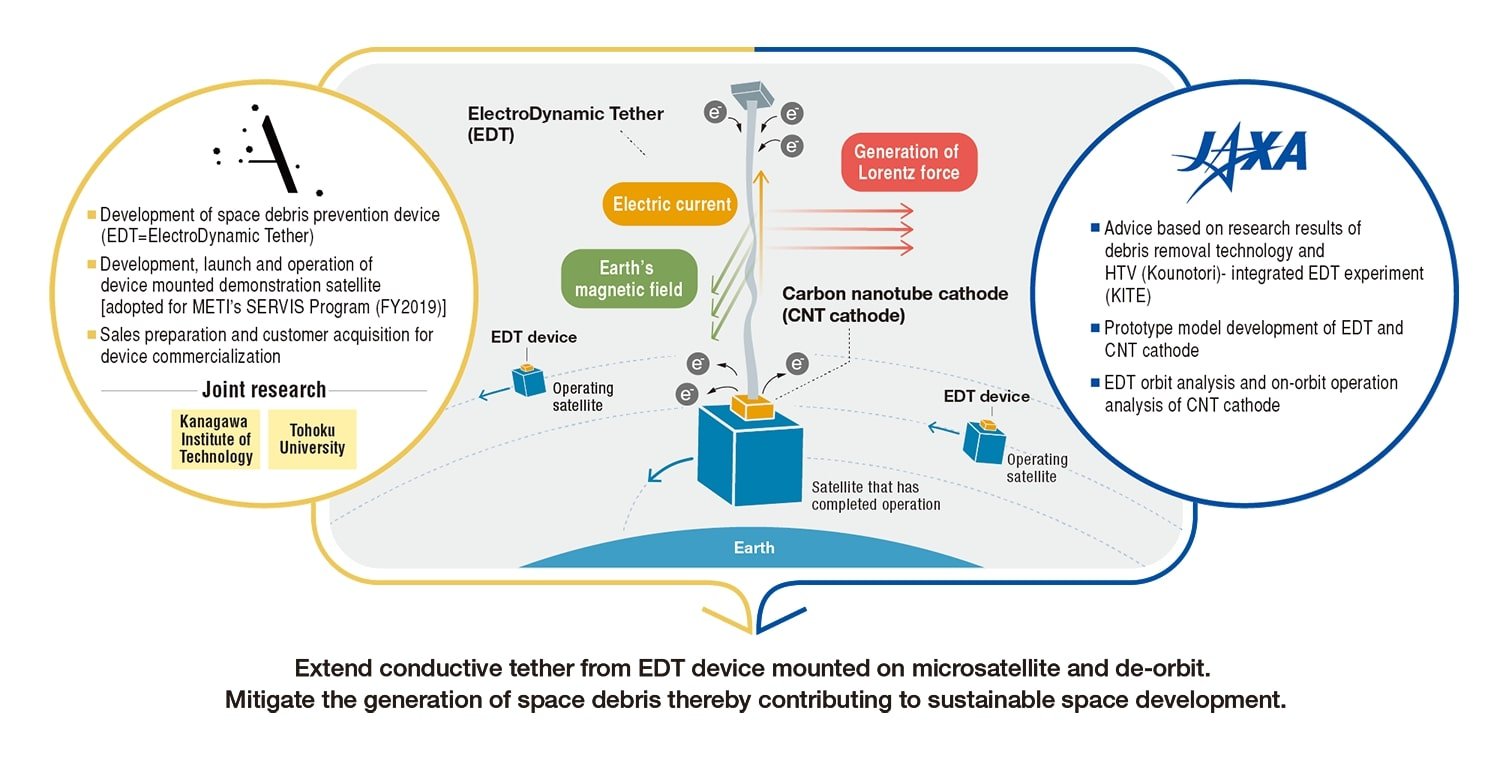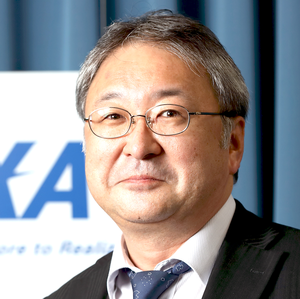ALE Co., Ltd. (Minato-ku, Tokyo; Lena Okajima, CEO) and Japan Aerospace Exploration Agency (Headquarters: Chofu-shi, Tokyo; Hiroshi Yamakawa, President; hereinafter “JAXA”), as a project of the JAXA Space Innovation through Partnership and Co-creation (J-SPARC) initiative, are engaged in the “commercialization of space debris prevention devices that work by promptly deorbiting satellites after the completion of their mission,” as a space debris mitigation measure (*1). Having co-created the concepts of the project, the two partners have now moved on to the joint demonstration phase. In the joint demonstration phase, ALE and JAXA will collaborate toward launching their space debris prevention device aboard a nano-satellite during fiscal 2021 for demonstration in space. Following the demonstration, ALE aims to develop a business to manufacture and market the device.

This “space debris prevention device” is the world’s first device using a carbon nanotube (CNT) cathode and an electrodynamic tether (EDT) (*2). The device is mounted onto a satellite prior to its launch. After completion of the mission, a long tether is extended into space to change the orbit of the satellite induced by the Earth’s magnetic field. By lowering the orbits of satellites within a short period of time, they will reenter the Earth’s atmosphere and burn up.
In the joint demonstration, based on the knowledge derived from the co-creation of the concepts, ALE is responsible for: developing and demonstrating the EDT devices including the CNT cathode (*3); developing, launching and operating a nano-satellite with the devices on board (*4); and preparing for the commercialization. Meanwhile, JAXA will create a prototype model for the EDT and CNT cathode, and conduct EDT orbit analysis and evaluation of on-orbit operation of the CNT cathode.

By the development of the device with this joint onboard demonstration, it will become possible to reduce the number of satellites remaining in a low Earth orbit, which is expected to increase rapidly in the future, and to thereby prevent the generation of large quantities of hazardous debris caused by collisions with other space debris. ALE and JAXA will promote this joint demonstration as one of JAXA’s initiatives to mitigate the space debris issue and contribute to sustainable space development.
[Comments from the representatives]

Lena Okajima, President/CEO of ALE Co., Ltd.
“ALE is a start-up company which has challenged the world’s first man-made shooting stars using satellites. In 2019, the company succeeded in launching 2 shooting-star satellites which are currently operating in orbit. We aim to contribute to the sustainable development of humankind and will continue to engage in creating a sustainable space environment through this device. Through the J-SPARC partnership with JAXA that has an abundance of research and development achievements, we are hoping to accelerate the speed of development and achieve the target of the project at an early stage. “

Hiroyuki Iwamoto, Director of Business Development and Industrial Relations Department, JAXA
“The space debris prevention device is designed to change the orbit of spacecraft to prevent becoming debris after completing its mission. I believe this project is one of significant initiatives in space debris mitigation measures. This is the first joint demonstration project as a J-SPARC initiative, and we hope that JAXA’s technical research results will be utilized in private space enterprises, thereby contributing to the realization of sustainable space-related activities. “
(*1) International environment surrounding space debris mitigation measures:
Space debris mitigation measures that are being considered include methods to remove space debris already in orbit (ADR: Active Debris Removal) (Note 1) and methods to promptly deorbit satellites after the completion of their mission (PMD:Post Mission Disposal). The device being developed by ALE corresponds to PMD. Actions are being taken in various countries around the world and by international organizations to impose legal obligations on businesses to implement measures to reduce space debris. Amid such a climate, there are increasing expectations for PMD.
(Note 1) At JAXA, comprehensive space debris mitigation measures are being promoted and CRD2 (Commercial Removal of Debris Demonstration) is being implemented for the realization of ADR.
Commercial Removal of Debris Demonstration:
http://www.kenkai.jaxa.jp/research/debris/crd2/crd2.html
(*2) Carbon NanoTube (CNT) cathode and ElectroDynamic Tether (EDT) device:
EDT is a lightweight propulsion device to extend a long tether in space and change the satellite orbit using earth’s magnetic field. CNT cathode is an electron-emitting device using carbon nanotube and in combination with EDT, deorbiting may be carried out effectively and the time required in lowering the altitude may be reduced significantly. This is the world’s first PMD device used in combination with CNT cathode and EDT.
(*3) Development and demonstration of EDT device:
In developing and demonstrating this device, ALE has collaborated with Kanagawa Institute of Technology which specializes in knowledge regarding EDT behavior to conduct joint research on the mechanical behavior of long objects during EDT unfolding in orbit and during descent from orbit.
(*4) Development, launching and operation of nano-satellites:
ALE has collaborated with Tohoku University with which they already have joint achievements in satellite operation, utilizing their knowledge on the development and operation of the nano-satellite system. They will conduct joint research on the development and operation of nano-satellites with these devices mounted thereon.
*ALE’s press release regarding concept co-creation activities (Feb, 2019)
http://star-ale.com/en/news/2019/02/28/000063.html